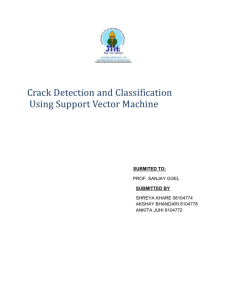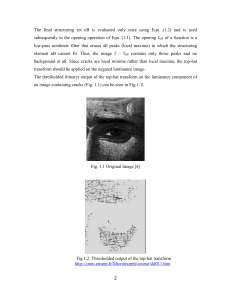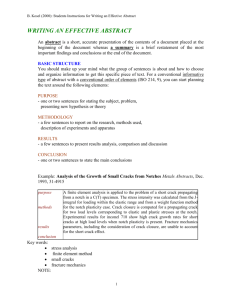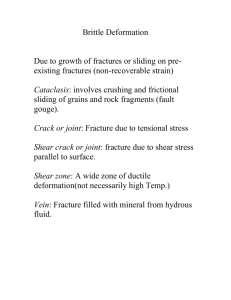INTERACTION BETWEEN LINE CRACKS IN AN ORTHOTROPIC LAYER SUBIR DAS
advertisement
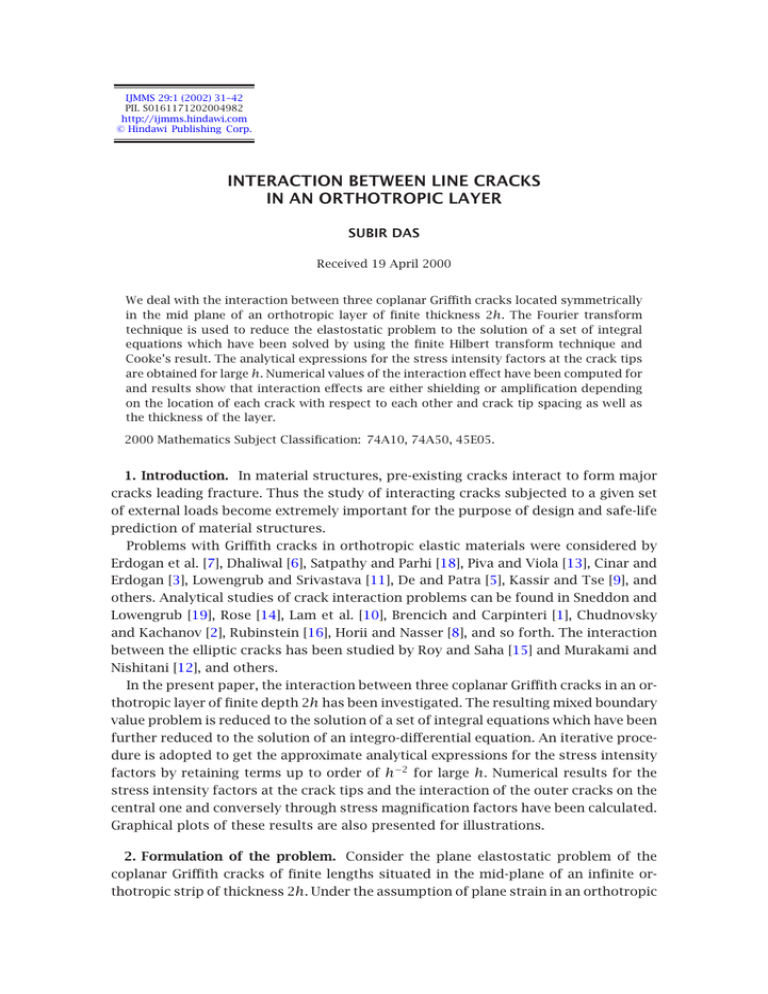
IJMMS 29:1 (2002) 31–42 PII. S0161171202004982 http://ijmms.hindawi.com © Hindawi Publishing Corp. INTERACTION BETWEEN LINE CRACKS IN AN ORTHOTROPIC LAYER SUBIR DAS Received 19 April 2000 We deal with the interaction between three coplanar Griffith cracks located symmetrically in the mid plane of an orthotropic layer of finite thickness 2h. The Fourier transform technique is used to reduce the elastostatic problem to the solution of a set of integral equations which have been solved by using the finite Hilbert transform technique and Cooke’s result. The analytical expressions for the stress intensity factors at the crack tips are obtained for large h. Numerical values of the interaction effect have been computed for and results show that interaction effects are either shielding or amplification depending on the location of each crack with respect to each other and crack tip spacing as well as the thickness of the layer. 2000 Mathematics Subject Classification: 74A10, 74A50, 45E05. 1. Introduction. In material structures, pre-existing cracks interact to form major cracks leading fracture. Thus the study of interacting cracks subjected to a given set of external loads become extremely important for the purpose of design and safe-life prediction of material structures. Problems with Griffith cracks in orthotropic elastic materials were considered by Erdogan et al. [7], Dhaliwal [6], Satpathy and Parhi [18], Piva and Viola [13], Cinar and Erdogan [3], Lowengrub and Srivastava [11], De and Patra [5], Kassir and Tse [9], and others. Analytical studies of crack interaction problems can be found in Sneddon and Lowengrub [19], Rose [14], Lam et al. [10], Brencich and Carpinteri [1], Chudnovsky and Kachanov [2], Rubinstein [16], Horii and Nasser [8], and so forth. The interaction between the elliptic cracks has been studied by Roy and Saha [15] and Murakami and Nishitani [12], and others. In the present paper, the interaction between three coplanar Griffith cracks in an orthotropic layer of finite depth 2h has been investigated. The resulting mixed boundary value problem is reduced to the solution of a set of integral equations which have been further reduced to the solution of an integro-differential equation. An iterative procedure is adopted to get the approximate analytical expressions for the stress intensity factors by retaining terms up to order of h−2 for large h. Numerical results for the stress intensity factors at the crack tips and the interaction of the outer cracks on the central one and conversely through stress magnification factors have been calculated. Graphical plots of these results are also presented for illustrations. 2. Formulation of the problem. Consider the plane elastostatic problem of the coplanar Griffith cracks of finite lengths situated in the mid-plane of an infinite orthotropic strip of thickness 2h. Under the assumption of plane strain in an orthotropic 32 SUBIR DAS medium, the displacement equations of motion are C11 ∂2v ∂2u ∂2u = 0, + C66 + C12 + C66 ∂x 2 ∂y 2 ∂x∂y ∂2u ∂2v ∂2v + C + C + C = 0. C22 66 12 66 ∂y 2 ∂x 2 ∂x∂y (2.1) The stress displacement relations are ∂u ∂v + C12 , ∂x ∂y ∂v ∂u + , = C22 ∂y ∂x ∂u ∂v + . = C66 ∂y ∂x σxx = C11 σyy σxy (2.2) The problem is symmetric with respect to y = 0. Assuming the cracks |x| < b, c < |x| < 1, y = 0 opened by normal pressure p(x), the boundary conditions for the problem to be studied are σyy (x, 0) = −p(x), v(x, 0) = 0, σxy (x, 0) = 0, |x| < b, c < |x| < 1, (2.3) b ≤ |x| ≤ c, |x| ≥ 1, (2.4) |x| < ∞, (2.5) and on y = h u(x, h) = 0, |x| < ∞, (2.6) v(x, h) = 0, |x| < ∞. (2.7) In addition all the components of stress and displacement vanish at the remote distances from the cracks. 3. Solution of the problem. The appropriate solution of (2.1) can be taken as ∞ A(s, y) sin sx ds, u(x, y) = 0 v(x, y) = ∞ (3.1) B(s, y) cos sx ds, 0 where A and B are functions of y satisfying the equations C11 s 2 A − C66 dB d2 A = 0, + C12 + C66 s dy 2 dy dA d2 B − C12 + C66 s = 0, C66 s B − C22 dy 2 dy (3.2) 2 which has the solution for the layer as A(s, y) = A1 (s)ch γ1 sy + A2 (s)ch γ2 sy + C1 (s)sh γ1 sy + C2 (s)sh γ2 sy , (3.3) B(s, y) = B1 (s)sh γ1 sy + B2 (s)sh y2 sy + D1 (s)ch γ1 sy + D2 (s)ch γ2 sy , INTERACTION BETWEEN LINE CRACKS IN AN ORTHOTROPIC LAYER 33 in which γ1 and γ2 (< γ1 ) are positive roots of the equation C66 C22 γ 4 + 2 2 2 C12 + C66 − C11 C22 − C66 γ + C11 C66 = 0, (3.4) and Bj (s), Dj (s) are related to Aj (s) and Cj (s) by Bj (s) = − where αj Aj (s), γj Dj (s) = − C11 − γj2 C66 , αj = C12 + C66 αj Cj (s), γj j = 1, 2. (3.5) (3.6) The expressions for the stresses are σxy (x, y) = C66 ∞ 0 β2 β1 A1 (s)sh γ1 sy + A2 (s)sh γ2 sy γ1 γ2 + σyy (x, y) = ∞ β2 β1 C1 (s)ch γ1 sy + C2 (s)ch γ2 sy s sin sx ds, γ1 γ2 C12 − C22 α1 A1 (s)ch γ1 sy + C12 − C22 α2 A2 (s)ch γ2 sy 0 + C12 −C22 α1 C1 (s)sh γ1 sy + C12 −C22 α2 C2 (s)sh γ2 sy s cos sx ds. (3.7) Applying (2.5), we obtain C2 (s) = − β1 γ2 C1 (s), β2 γ1 (3.8) with βj = αj + γj2 , j = 1, 2. (3.9) The boundary conditions (2.6) and (2.7) in conjunction with (3.8) give rise to A1 (s) = δ1 (sh)C1 (s), A2 (s) = δ2 (sh)C1 (s), (3.10) whose δ1 (sh), δ2 (sh) are known functions and are given by α2 β1 /β2 γ1 +(α2 /γ2 )sh γ1 sh sh γ2 sh −(α1 /γ1)ch γ1 sh ch γ2 sh , (α1 /γ1 )sh γ1 sh ch γ2 sh − (α2 /γ2 )sh(γ2 sh)ch γ1 sh α1 /γ1 + (α1 β1 γ2 /β2 γ12 )sh γ1 sh sh γ2 sh (3.11) δ2 (sh) = (α1 /γ1 )sh γ1 sh ch γ2 sh − (α2 /γ2 )sh γ2 sh ch γ1 sh (α2 β1 /β2 γ1 )ch γ1 sh ch γ2 sh . − (α1 /γ1 )sh γ1 sh ch γ2 sh − (α2 /γ2 )sh γ2 sh ch γ1 sh δ1 (sh) = 34 SUBIR DAS The boundary conditions (2.3) and (2.4) finally yield the following integral equations: ∞ 0 1 sC1 (s)[1 + M(sh)] cos sx ds = − p(x), 0 < x < b, c < x < 1, D ∞ C1 (s) cos sx ds = 0, b < x < c, x > 1, (3.12) (3.13) 0 where C12 − C22 α1 δ1 (sh) + C12 − C22 α2 δ2 (sh) , M(sh) = − 1 + D β1 γ2 D = C12 − C22 α1 − C12 − C22 α2 . β2 γ1 (3.14) It should be noted that M(sh) → 0 as h → ∞. Setting C1 (s) = b 1 s 0 h(t) sin st dt + 1 s 1 g u2 sin su du, (3.15) c where h(t) and g(u2 ) are the unknown functions. Using the result ∞ 0 π , sin st cos sx ds = 2 s 0, t > x, (3.16) t < x, it is found that (3.13) is identically satisfied if 1 g u2 du = 0. (3.17) u+x 1 sin su sin sx , ds = log s 2 u−x (3.18) c Further, using the result ∞ 0 equation (3.12) under (3.15) leads to d dx 1 u+x t +x 2 dt + d log h(t) log g u u − x du t −x dx c 0 ∞ d b h(t)dt s −1 M(sh) sin st sin sx ds + dx 0 0 ∞ d 1 2 + g u du s −1 M(sh) sin su sin sx ds dx c 0 b =− 2 p(x), D 0 < x < b, c < x < 1. (3.19) 35 INTERACTION BETWEEN LINE CRACKS IN AN ORTHOTROPIC LAYER Now assuming 1 1 h (t) + O , 1 h2 h4 1 1 , g u2 = g 0 u2 + 2 g 1 u2 + O h h4 h(t) = h0 (t) + (3.20) for large h, integral equation (3.19) reduces to ug0 u2 )du 2 = − p(x) 2 − x2 u D 0 c b 1 ug1 u2 du d t +x |dt + 2 h1 (t) log | dx 0 t −x u2 − x 2 c 1 b 2 = −2P th0 (t)dt + ug0 u du , 0 < x < b, c < x < 1 d dx b h0 (t) log | t +x |dt + 2 t −x 0 with 1 (3.21) (3.22) c 1 c gi u2 du = 0, i = 0, 1, (3.23) where P= 1 D α1 / γ1 − α2 / γ2 α1 α2 α1 α2 1 β1 × + − C α + − C α + C C 12 22 1 12 22 2 γ1 γ2 2β2 γ1 γ2 γ1 γ2 2γ12 α1 β2 1 α2 β1 C12 − C22 α2 × C12 − C22 α1 − + 2 . β2 γ1 α2 β1 γ1 + γ2 (3.24) Rewriting equation (3.21) as t +x h0 (t) log t − x dt = π F1 (x), 0 b where F1 (x) = − 1 π x 0 2 p(y) + D 2ug0 y 2 du dy 2 2 c u −y (3.25) 1 (3.26) and using Cooke’s result [4], the solution of the integral equation is found to be h0 (t) = t t 4 2 √ P1 (t) − √ 2 π 2 D b2 − t 2 π b − t2 where 1√ c u2 − b2 g0 (y 2 ) du, u2 − t 2 (3.27) b√ P1 (t) = 0 b2 − x 2 p(x)dx, x2 − t2 (3.28) 36 SUBIR DAS then the integral equation for g0 (u2 ) is derived as 1√ 2 u − b2 g0 u2 du = −F2 (x) u2 − x 2 c with F2 (x) = (3.29) √ b 4 x 2 − b2 1 t 2 P1 (t) √ dt . p(x) + 2 x D π D 0 b2 − t 2 t 2 − x 2 (3.30) Now using Hilbert transform technique (see Sarkar et al. [17]), the solution to (3.27) is found to be g 0 u2 = 2u 2 2 π u −c 1 − u2 u 2 − b 2 1 x 2 x 2 − c 2 1 − x 2 c x 2 − u2 F2 (x)dx (3.31) uk1 + , u2 − c 2 1 − u2 u2 − b 2 where k1 is an unknown constant to be determined from (3.23). Then the closed form of the expression for h0 (t) may be obtained from (3.27) when the use of (3.29) is made there. Again applying the same procedure and using the above result, analytical expressions of h1 (t) and g1 (u2 ) may be derived. As a particular case of the problem setting p(x) = p, a constant, analytical expressions for hj (t) and gj (u2 ), j = 0, 1 are obtained as 2p t 2 c 2 − t 2 tk1 + h0 (t) = − , D b2 − t 2 1 − t 2 2 2 b − t c2 − t2 1 − t2 2P R t 2 c 2 − t 2 tk2 − h1 (t) = − , b2 − t 2 1 − t 2 π 2 2 b − t c2 − t2 1 − t2 2 2p u2 u2 − c 2 uk1 + g0 u = − , u 2 − b 2 1 − u2 D 2 2 u − b u 2 − c 2 1 − u2 (3.32) 2 2P R u2 u2 − c 2 uk2 + g1 u = − , π u2 − b 2 1 − u2 2 2 u − b u2 − c 2 1 − u 2 where 2p b I0 + Ic1 − K1 J0b − Jc1 , D √ n t2 c2 − t2 n Im = dt, m b2 − t 2 1 − t 2 n t 2 dt n Jm = , m b2 − t 2 c 2 − t 2 1 − t 2 R=− kj = Aj E 2 − c − b2 , 1 − b2 F j = 1, 2, (3.33) INTERACTION BETWEEN LINE CRACKS IN AN ORTHOTROPIC LAYER with A1 = 2p , D A2 = 2P R . π 37 (3.34) In the above, F = F (π /2, q) and E = E (π /2, q) are the elliptic integrals of first and second kinds, respectively, and q = (1 − c 2 )/(1 − b2 ). The stress intensity factors Kb , Kc , and K1 at the crack tips x = b, x = c, and x = 1 of the cracks are found to be Kb = lim 2(x − b)σyy (x, 0) = p x→c+ b 1 − b2 E 2P W 1 − + O h−4 , c 2 − b2 F π h2 Kc = lim 2(c − x)σyy (x, 0) x→c− E 2 2P W c 2 1 − b2 1 − − c + O h−4 , − b =p 2 c − b2 1 − c 2 F π h2 2P W 1 − b2 E 1 − 1 − + O h−4 , K1 = lim 2(x − 1)σyy (x, 0) = p x→1− 1 − c2 F π h2 (3.35) (3.36) (3.37) where E 2 b J0 − Jc1 . − c − b2 W = I0b + Ic1 + 1 − b2 F (3.38) The stress magnification factors Mb , Mc , and M1 at the crack tips x = b, x = c, and x = 1 are defined as Mb = Kb /Kb∗ , Mc = Kc /Kc∗ , M1 = K1 /K1∗ , where Kb∗ is the stress intensity factor at x = b due to the presence of the central crack only and Kc∗ , K1∗ are the stress intensity factors at x = c, x = 1, respectively, due to the presence of outer cracks only and these are given by E 2P Q1 1− Kb∗ = p b + O h−4 , F π h2 (3.39) E − 1 J0b , Q1 = I0b + 1 − b2 F p 2P Q2 E 2 Kc∗ = 1− + O h−4 , F −c 2 π h 2 c 1−c p 2P Q2 E 1 − 1 − + O h−4 , K1∗ = √ F π h2 1 − c2 E Q2 = Ic1 − − c 2 Jc1 . F (3.40) where 4. Numerical results and discussion. As a particular case of the problem, the orthotropic material is considered to be α-Uranium. Values of the material constants are taken as α-Uranium C11 21.47 C22 19.86 C12 4.65 C66 7.43 38 SUBIR DAS 0.9 c = 0.6 0.85 0.8 c = 0.7 Kb /p 0.75 c = 0.8 0.7 0.65 0.6 2 4 6 8 h Figure 4.1. Plot of Kb /p versus h at b = 0.5. c = 0.6 0.7 0.6 Kc /p c = 0.7 0.5 0.4 c = 0.8 0.3 0.2 2 4 6 8 h Figure 4.2. Plot of Kc /p versus h at b = 0.5. 0.9 0.85 c = 0.6 0.8 c = 0.7 c = 0.8 K1 /p 0.75 0.7 0.65 0.6 2 4 6 h Figure 4.3. Plot of K1 /p versus h at b = 0.5. 8 INTERACTION BETWEEN LINE CRACKS IN AN ORTHOTROPIC LAYER 0.9 b = 0.4 0.8 b = 0.3 0.7 Kb /p b = 0.2 0.6 b = 0.1 0.5 0.4 2 4 6 8 h Figure 4.4. Plot of Kb /p versus h at c = 0.5. 0.775 b = 0.4 0.725 0.675 Kc /p b = 0.3 0.625 0.575 b = 0.2 b = 0.1 0.525 0.475 2 4 6 8 h Figure 4.5. Plot of Kc /p versus h at c = 0.5. 0.84 b = 0.4 0.82 b = 0.3 0.8 b = 0.2 b = 0.1 K1 /p 0.78 0.76 0.74 0.72 0.7 2 4 6 h Figure 4.6. Plot of K1 /p versus h at c = 0.5. 8 39 40 SUBIR DAS 1.5 Mb 1.25 c = 0.6 1 c = 0.7 c = 0.8 0.75 0.5 2 4 6 8 h Figure 4.7. Plot of Mb versus h at b = 0.5. 2 b = 0.4 1.75 1.5 b = 0.3 Mc 1.25 b = 0.2 b = 0.1 1 0.75 2 4 6 8 h Figure 4.8. Plot of Mc versus h at c = 0.5. 1.25 b = 0.4 1.125 b = 0.3 b = 0.2 b = 0.1 M1 1 0.875 2 4 6 h Figure 4.9. Plot of M1 versus h at c = 0.5. 8 INTERACTION BETWEEN LINE CRACKS IN AN ORTHOTROPIC LAYER 41 The stress intensity factors Kb , Kc , and K1 at the tips of the cracks opened by a constant pressure p have been plotted against h. Keeping the central crack length fixed (b = 0.5), stress intensity factors at the tips of the central and outer cracks have been plotted against the depth h for different outer crack lengths c = 0.6, 0.7, 0.8. It is observed from Figures 4.1, 4.2, and 4.3, that the stress intensity factors Kb , Kc , and K1 decrease with the decrease in outer crack length, that is, with the increase in the distances between the inner and outer cracks and also with the decrease in h for different outer crack lengths. Again, on keeping the outer crack length fixed at c = 0.5, it is observed from Figures 4.4, 4.5, and 4.6 that the stress intensity factors increase with an increase in both h and b. Regarding interactions between the central and the external cracks, plots of stress magnification factors through Figures 4.7, 4.8, and 4.9 have been made. It is observed from Figure 4.7 that on keeping the central crack length fixed at b = 0.5 the stress magnification factor Mb decreases with a decrease in the outer crack lengths and increase with an increase in h. In this case the interaction effect of outer crack on central crack is a mixture of amplification and shielding. When the outer crack is relatively smaller (c = 0.8) and depth of the layer is narrower (h = 2) the shielding effect is maximum. Maximum amplification is attained at the crack tip nearest to the adjacent central crack (c = 0.6) and at large depth h = 8. It is seen from Figures 4.8 and 4.9 that the stress magnifications Mc and M1 increase with an increase in the central crack length and also with an increase in h when the outer crack length is fixed at c = 0.5. It is clearly seen that the effect of central crack on the outer cracks is amplification. At both the ends amplifications are maximum when the central crack length and depth of the layer become large (b = 0.4, h = 8). 5. Conclusion. We have seen that the central and outer cracks interaction effect is a mixture of shielding and amplification or simply amplification depending on the length of the cracks and the depth of the layer. When the outer crack is smaller, there is possible crack arrest of the central crack. When the outer crack is broad, there is a propagation tendency of the central crack towards the outer crack. Again as the central crack length increases, the propagation tendency of outer crack at both ends increase due to increase of amplifications. References [1] [2] [3] [4] [5] A. Brencich and A. Carpinteri, Interaction of a main crack with ordered distributions of microcracks: a numerical technique by displacement discontinuity boundary elements, Internat. J. Fracture 76 (1996), 373–389. A. Chudnovsky and M. Kachanov, Interaction of a crack with a field of microcracks, Internat. J. Engrg. Sci. 21 (1983), 1009–1018. A. Cinar and F. Erdogan, The crack and wedging problem for an orthotropic strip, Internat. J. Fracture 23 (1983), 83–102. J. C. Cooke, The solution of some integral equations and their connection with dual integral equations and series, Glasgow Math. J. 11 (1970), 9–20. J. De and B. patra, Moving Griffith crack in an orthotropic strip, Internat. J. Engrg. Sci. 28 (1990), 809–819. 42 [6] [7] [8] [9] [10] [11] [12] [13] [14] [15] [16] [17] [18] [19] SUBIR DAS R. S. Dhaliwal, Two coplanar cracks in an infinitely long orthotropic elastic strip, Utilitas Math. 4 (1973), 115–128. F. Erdogan, G. Gupta, and T. S. Cook, Numerical solution of singular integral equations, Mechanics of Fracture, vol. 1, Noordhoff, Leiden, 1973, pp. 368–425. M. Horii and S. Neman-Nasser, Interacting micro-cracks near the tip in the process zone of a macro-crack, J. Mech. Phys. Solids 35 (1987), 601–629. M. K. Kassir and S. Tse, Moving Griffith crack in an orthotropic material, Internat. J. Engrg. Sci. 21 (1983), 315–325. K. Y. Lam, C. Wen, and Z. Phua, Interaction between medium, Engrg. Fracture Mech. 44 (1993), 753–761. M. Lowengrub and K. N. Srivastava, Two coplanar Griffith cracks in an infinitely long elastic strip, Internat. J. Engrg. Sci. 6 (1968), 425–434. Y. Murakami and H. Nishitani, Stress intensity factors for interacting two equal semi-elliptic surface cracks in tension, Transaction of JSME 47 (1981), 295–303. A. Piva and E. Viola, Crack propagating in an orthotropic medium, Engrg. Fracture Mech. 29 (1988), 535–548. L. R. Rose, Microcrack interaction with a main crack, Internat. J. Fracture 31 (1986), 233– 242. A. Roy and T. K. Saha, Interaction of a penny-shaped crack with an elliptic crack, Internat. J. Fracture 73 (1995), 51–65. A. Rubinstein, Microcrack-microdefect interaction, J. Appl. Math. Mech. 53 (1986), 505– 510. J. Sarkar, S. C. Mandal, and M. L. Ghosh, Diffraction of elastic waves by three coplanar Griffith cracks in an orthotropic medium, Internat. J. Engrg. Sci. 33 (1995), 163– 177. P. K. Satpathy and H. Parhi, Stresses in an orthotropic strip containing a Griffith crack, Internat. J. Engrg. Sci. 16 (1978), 147–154. I. N. Sneddon and M. Lowengrub, Crack Problems in the Classical Theory of Elasticity, John Wiley & Sons, New York, 1969. Subir Das: Department of Mathematics, B.P. Poddar Institute of Management and Technology Poddar Vihar, 137, VIP Road, Calcutta-52, India



